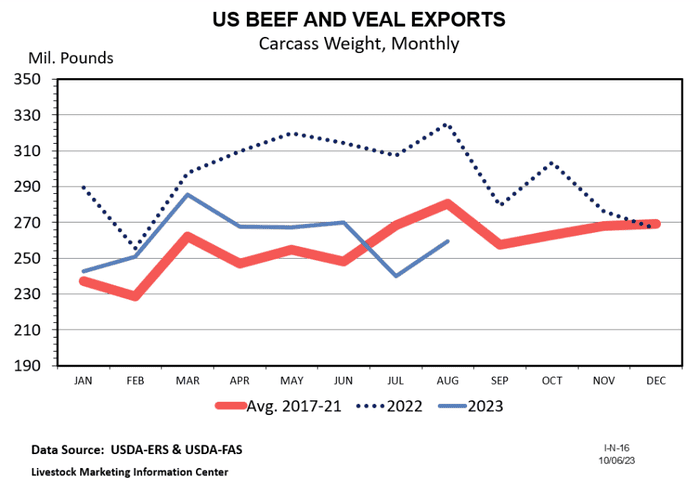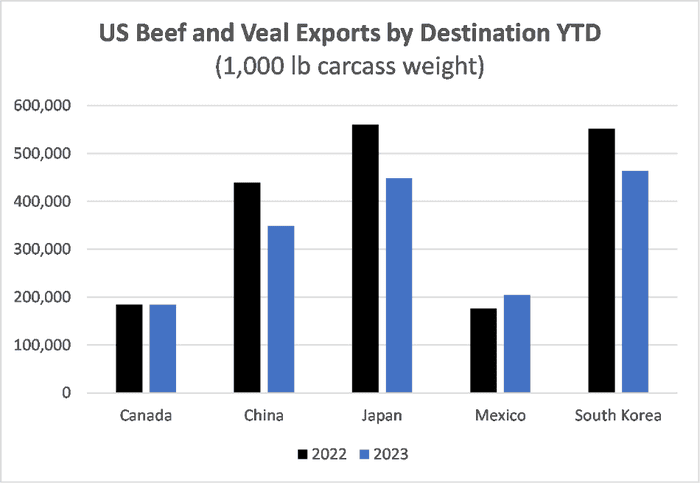October 19, 2023

While the vast majority of beef produced in the US is consumed domestically, international markets are a significant piece of the US beef system. For perspective, the US exported the equivalent of about 12.5% of its beef production during 2022, while importing roughly 12%. This was a fairly typical balance of trade, especially for a year with high beef production levels like last year. However, as beef production is on track to see a significant drop in 2023, trade patterns are also being impacted.
 Through August, exports of US beef are down by 14% from the first eight months of 2022. A drop of that magnitude certainly warrants some question, but can largely be explained by supply fundamentals. For the first two quarters of 2023, beef production was about 4% lower than 2022. With lower production levels, a larger share of US production will be consumed domestically. Additionally, high price levels are also making imports of US beef less attractive in many countries. For example, exports to our three largest destinations (South Korea, Japan, and China) are all down sharply so far this year.
Through August, exports of US beef are down by 14% from the first eight months of 2022. A drop of that magnitude certainly warrants some question, but can largely be explained by supply fundamentals. For the first two quarters of 2023, beef production was about 4% lower than 2022. With lower production levels, a larger share of US production will be consumed domestically. Additionally, high price levels are also making imports of US beef less attractive in many countries. For example, exports to our three largest destinations (South Korea, Japan, and China) are all down sharply so far this year.
 The same factors that have led to lower export levels have also led to an increase in US beef imports. Through the first eight months of the year, US beef imports are up by a little over 5%. The largest percentage increases are in beef imports from Australia, New Zealand, and Uruguay, which are primarily markets where the US imports lean trim. Unlike 2022 when the US was a slight net exporter of beef, we are very much on track to be a significant net importer in 2023. Through August, US beef imports have exceeded exports by more than 20%.
The same factors that have led to lower export levels have also led to an increase in US beef imports. Through the first eight months of the year, US beef imports are up by a little over 5%. The largest percentage increases are in beef imports from Australia, New Zealand, and Uruguay, which are primarily markets where the US imports lean trim. Unlike 2022 when the US was a slight net exporter of beef, we are very much on track to be a significant net importer in 2023. Through August, US beef imports have exceeded exports by more than 20%.
 This trend towards increased imports and decreased exports is likely to continue for the next few years. Given that this calf crop is smaller than last year’s calf crop, beef production is likely to decrease in 2024. And given expectations for lower beef cow inventory next year, I would expect beef production to be lower again in 2025. The same supply fundamentals supporting strong cattle prices are resulting in a significant shift in the balance of trade for beef. And as beef supplies get increasingly tighter over the next couple of years, we are likely to see an ever greater divergence between imports and exports.
This trend towards increased imports and decreased exports is likely to continue for the next few years. Given that this calf crop is smaller than last year’s calf crop, beef production is likely to decrease in 2024. And given expectations for lower beef cow inventory next year, I would expect beef production to be lower again in 2025. The same supply fundamentals supporting strong cattle prices are resulting in a significant shift in the balance of trade for beef. And as beef supplies get increasingly tighter over the next couple of years, we are likely to see an ever greater divergence between imports and exports.
About the Author(s)
You May Also Like






